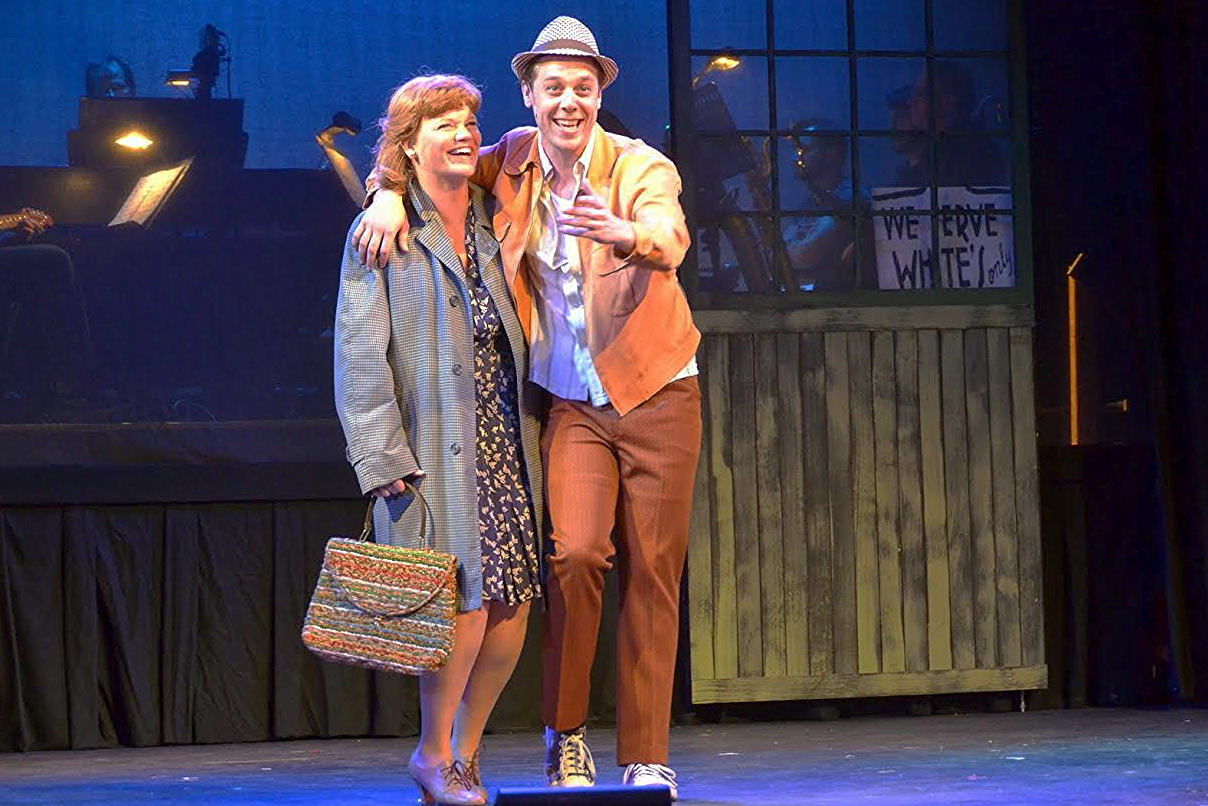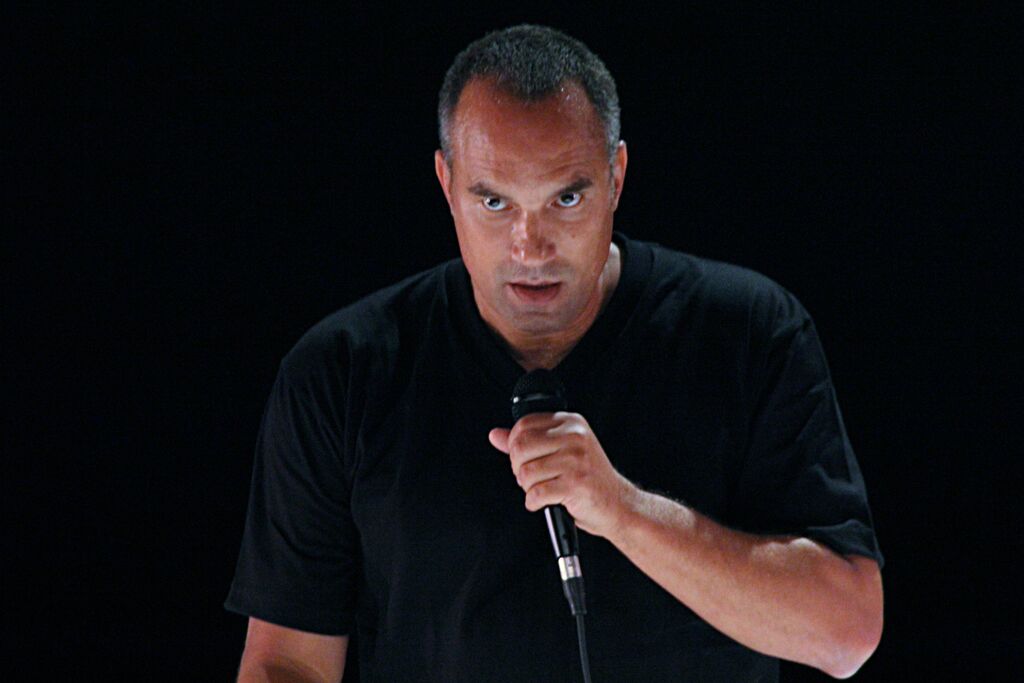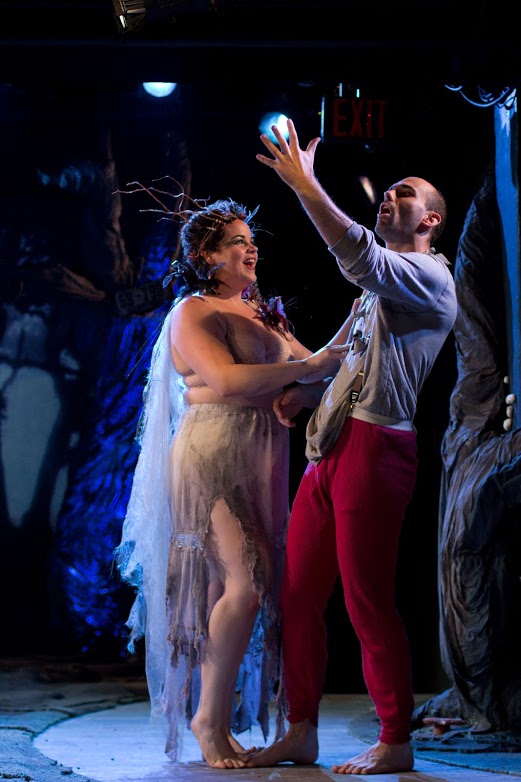Review of I’m With You in Rockland, Yale Cabaret
Allen Ginsberg, an influential American poet who died in 1997, is best-known for his poem "Howl" (1957), which includes the repeated phrase “I’m With You in Rockland.” Taking that as the title for a theater-piece “inspired by the life and work of Allen Ginsberg,” Kevin Hourigan and Company have mounted at Yale Cabaret a somewhat antagonistic tribute to the Beat poet who wrote “I saw the best minds of my generation destroyed by madness, starving hysterical naked . . . .”
Dylan Mattingly, Ian Gottlieb, Fred Kennedy
One could say there are actually three tributes, or, more properly, reactions to Ginsberg going on here. Representing the Yale School of Art, Alteronce Gumby makes art on stage; representing the Yale School of Music, three musicians, Ian Gottlieb, cello, Fred Kennedy, percussion, and Dylan Mattingly, piano, create sound textures that, especially with Kennedy’s inventive percussive effects and Mattingly’s frenetic playing, are the high point of the evening. Representing the Yale School of Drama, six performers, aided by a cascade of videos on several TVs, grapple with the task of raising a “Howl” of their own.
standing: Alteronce Gumby; seated: Nahuel Telleria, Helen Jaksch, Lynda Paul, Kevin Hourigan
Somewhere behind all this busyness is the notion of what “the Beats” as a very hip, very small but eventually very influential subculture of the late Fifties were all about. The “coolness” and "saintliness" of the Beat posture is best served, in this show, by Gumby as he takes the stage and flicks liquid from a styrofoam cup, then pulls a flower out of his mouth. The jazzier offerings by the musicians—at times cool, at times a bit more frenzied—also evince the movement. The performers’ have their work cut out for them.
Josh Goulding as Ginsberg
It doesn’t help that, before the show starts, we’re treated to loops of video from James Franco’s film Howl, and that Josh Goulding, who enacts Ginsberg at his trusty typewriter, looks more like Franco as Ginsberg than like Ginsberg. Sure, it could be the point that, for the artists behind this show, cultural history comes packaged by the powers that be (and who could be more empowered than celebrity art charlatan Franco?)—Ginsberg, who, in his heyday during the Sixties, was always part shaman, part showman, might dig it. Still, there are two things for which Ginsberg was the reigning “go to” guy in the subculture: being a Jew and being a queer (the latter his chosen term before “gay” became the accepted term). Neither aspect of Ginsberg’s persona gets coverage here, so, yeah, he might as well be Franco’d. (An exception is Lynda Paul’s amusing evocation of the male crotch, particularly asshole and balls—Ginsberg did more than anyone in U.S. letters to poeticize and eroticize the male body, in all its funkiness.)
Ginsberg and the Beats were talkers but, oddly, the show works best when no one’s talking. The performers—Kevin Hourigan, Helen Jaksch, Lynda Paul, Nahuel Telleria—berate Goulding/Ginsberg a bit tediously for his lame attempts to come up with that famous opening sentence of “Howl,” as though judges on an American Icon Game Show, all wearing what AG called “pubic beards” and seeming to be a Beats-meets-Marx Brothers array of zanies. But there is, thankfully, a bit of bite to some of the proceedings. This is today’s generation talking to hoary old Allen across a gulf of time in which, well, writing a poem doesn’t cut it any more. The performers ask Goulding/Ginsberg if he tried to intervene or do anything when he saw the sufferers he catalogs in his poem. “I saw, I wrote a poem,” he says, to sardonic applause.
Turning the tables, the troupe eventually get around to voicing their own “I saw . . .” litany of challenges, atrocities, and niceties of our day, but not before a little audience participation game that asks us to vote—with applause—which listed things we consider “a work of art.” By the time we get to war and acts of terrorism we can see where this is going. “Beauty will be convulsive or not at all,” surrealist capo André Breton said, a long time ago, and what could be more “convulsive” as “performance art” than crashing airliners into skyscrapers—at least that’s how avant-garde composer Karlheinz Stockhausen, in voice-over, sees it. How we got from gay, Jewish Ginsberg to goy, Germanic Stockhausen might wig us out a little, but, it seems, the troupe wants to know where to draw the line, artwise. (Poetry—which “makes nothing happen” in Auden’s formulation—never really comes up.)
Ginsberg, who was nothing if not a fully functioning human, with a broad and deep conception of humanity, might well look askance at the notion that a feat of engineering—particularly one with costly casualties—could be art. “Howl,” constructed “like a brick shithouse” in Ginsberg’s phrase, is. I’m With You in Rockland flirts with the edginess that made the Beats work, when they did, but it ends up feeling more like art school than art.
I’m With You in Rockland
Inspired by the life and work of Allen Ginsberg
Created by Kevin Hourigan with the Company
Creative Team: Kevin Hourigan, director and production designer; Jason Najjoum and Rachel Shuey, co-producers; Elizabeth Mak, lighting designer; Nok Kanchanabanca, sound designer; Michael Commendatore, projections designer; Avery Trunko, stage manager; Rae Powell, technical director; Ian Gottlieb, Dylan Mattingly, composers; Baize Buzan, Ricardo Dávila, Lucie Dawkins, Tori Sampson, additional contributing writers
Performers: Josh Goulding, Alteronce Gumby, Kevin Hourigan, Helen Jaksch, Lynda Paul, Nahuel Telleria, Avery Trunko; Musicians: Ian Gottlieb, Fred Kennedy, Dylan Mattingly
Yale Cabaret
October 8-10, 2015
















































